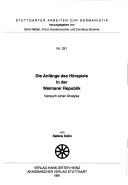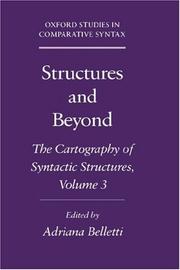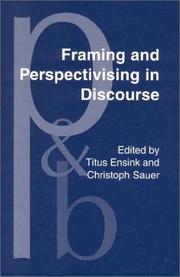| Listing 1 - 10 of 21 | << page >> |
Sort by
|
Book
ISBN: 9027269645 9789027269645 9027246645 9789027246646 9789027246646 1322215529 Year: 2014 Publisher: Amsterdam Philadelphia John Benjamins Pub. Co.
Abstract | Keywords | Export | Availability | Bookmark
 Loading...
Loading...Choose an application
- Reference Manager
- EndNote
- RefWorks (Direct export to RefWorks)
How do words mean? What is the nature of meaning? How can we grasp a word's meaning? The frame-semantic approach developed in this book offers some well-founded answers to such long-standing, but still controversial issues. Following Charles Fillmore's definition of frames as both organizers of experience and tools for understanding, the monograph attempts to examine one of the most important concepts of Cognitive Linguistics in more detail. The point of departure is Fillmore's conception of "frames of understanding" - an approach to (cognitive) semantics that Fillmore developed from 1975 to 1

ISBN: 388099255X Year: 1992 Publisher: Stuttgart Heinz
Abstract | Keywords | Export | Availability | Bookmark
 Loading...
Loading...Choose an application
- Reference Manager
- EndNote
- RefWorks (Direct export to RefWorks)
Discourse analysis [Literary ] --- Semiotics --- Frames (Linguistics)
Periodical
ISSN: 18761941 18761933 Year: 2009 Publisher: Amsterdam : John Benjamins Pub. Co.,
Abstract | Keywords | Export | Availability | Bookmark
 Loading...
Loading...Choose an application
- Reference Manager
- EndNote
- RefWorks (Direct export to RefWorks)
Book
ISBN: 3034321023 9783034321020 Year: 2016 Publisher: Bern Peter Lang
Abstract | Keywords | Export | Availability | Bookmark
 Loading...
Loading...Choose an application
- Reference Manager
- EndNote
- RefWorks (Direct export to RefWorks)
Cognitive grammar --- Frames (Linguistics) --- Latin language --- Romance languages --- Grammar, Comparative --- Romance --- Phonology, Historical --- Semantics --- Latin
Book
ISBN: 9783869626550 Year: 2023 Publisher: Köln, Germany : Herbert von Halem Verlag,
Abstract | Keywords | Export | Availability | Bookmark
 Loading...
Loading...Choose an application
- Reference Manager
- EndNote
- RefWorks (Direct export to RefWorks)
Die ARD-Sendung "Börse vor acht" (ehemals "Börse im Ersten", seit 2022 "Wirtschaft vor acht") hat den Anspruch, in kurzen TV-Beiträgen Ereignisse an der Börse zu erklären und zu analysieren. Dieses Buch untersucht die Erläuterungen der moderierenden Journalist*innen. Als theoretisches Konstrukt für die Analyse dient der Framing-Ansatz. Zur Erfassung der moralischen Dimension von Frames fanden erstmals die Kategorien der Moral Foundation Theory Anwendung. Ein weiteres Novum bei der Erforschung von Frames ist das Auffinden des bisher nicht beschriebenen Frame-Elements ›funktionale Bewertung‹. Gefundene Frames entsprechen einfachsten Stimulus-Response-Modellen. Die Moderator*innen erläutern darüber hinaus ein Phänomen, das in der Volkswirtschaftslehre als "Noise" bezeichnet wird - der tagesaktuelle Verlauf von Aktien ist demnach zwar rational nicht erklärbar, dennoch erklären die Journalist*innen Tagesverluste bzw. -gewinne von Aktien, Edelmetallen und Rohölpreisen.
Reporters and reporting. --- Journalism, Commercial. --- Economic history. --- Stock exchanges. --- Frames (Linguistics) --- Report writing.
Book
ISBN: 3111683575 3484309105 Year: 2017 Publisher: De Gruyter
Abstract | Keywords | Export | Availability | Bookmark
 Loading...
Loading...Choose an application
- Reference Manager
- EndNote
- RefWorks (Direct export to RefWorks)
Lexicography --- Frames (Linguistics) --- Artificial intelligence --- Semantics --- Data processing. --- Data processing. --- Data processing.

ISBN: 0195171969 0195171977 9786610843800 1423746066 0198038380 1280843802 1602564914 9781423746065 9780195171976 9780195171969 6610843805 9786610427970 6610427976 9781602564916 0197722504 0190291435 Year: 2004 Volume: 3 Publisher: Oxford New York Oxford University Press
Abstract | Keywords | Export | Availability | Bookmark
 Loading...
Loading...Choose an application
- Reference Manager
- EndNote
- RefWorks (Direct export to RefWorks)
Adriana Belletti here collects work by scholars presented at the University of Siena in connection with a visit by Noam Chomsky. The book's eight articles touch on broader theoretical questions related to Chomsky's Minimalist Program in particular. Contributors include Guglielmo Cinque, Richard Kayne, Luigi Rizzi, Noam Chomsky, and others.
Grammar, Comparative and general --- Syntax --- Grammar --- Linguistics --- Philology --- Minimalist theory (Linguistics) --- Frames (Linguistics) --- Semantics (Philosophy) --- Generative grammar
Book
ISBN: 3484311428 1306293146 3111674924 9783484311428 Year: 1993 Volume: 142 Publisher: Tübingen: Niemeyer,
Abstract | Keywords | Export | Availability | Bookmark
 Loading...
Loading...Choose an application
- Reference Manager
- EndNote
- RefWorks (Direct export to RefWorks)
Frames Und Lexikalisches Bedeutungswissen: Untersuchungen Zur Linguistischen Grundlegung Einer Frametheorie Und Zu Ihrer Anwendung in Der Lexikographie
Lexicology. Semantics --- Semantics. --- Frames (Linguistics) --- Lexicography. --- Linguistic analysis (Linguistics) --- Lexicography --- Semantics --- Formal semantics --- Semasiology --- Semiology (Semantics) --- Comparative linguistics --- Information theory --- Language and languages --- Lexicology --- Meaning (Psychology) --- Analysis, Linguistic (Linguistics) --- Analysis (Philosophy) --- Grammar, Comparative and general --- Encyclopedias and dictionaries --- Substitution frames (Linguistics) --- Syntactic frames (Linguistics)

ISBN: 9027253536 1588113655 128225541X 1423766512 9786612255410 9027296642 9781423766513 9789027253538 Year: 2003 Volume: 111 Publisher: Amsterdam Philadelphia, PA John Benjamins Pub.
Abstract | Keywords | Export | Availability | Bookmark
 Loading...
Loading...Choose an application
- Reference Manager
- EndNote
- RefWorks (Direct export to RefWorks)
In discourse, verbal messages are framed: speakers offer cues on the basis of which hearers are able to anchor the verbal message to the context. Furthermore, speakers cannot contribute to the discourse without at the same time showing their view on the subject matter of the discourse: the content of a discourse is necessarily 'displayed' from a certain perspective. Both the framing and perspectivising of verbal messages are not static, but subject to possible changes during the development of the discourse. Both concepts function at the intersection of a psychological-cognitive and a social-functional approach to discourse. In this volume, eight contributions are brought together which offer theoretical tools for describing and explaining framing and perspectivising devices in the production and comprehension of discourse, and apply them to the analysis of several types of discourse such as political satire, letters-to-the-editor, everyday narrations and newspaper reports.
Discourse analysis --- Frames (Linguistics) --- Perspective (Linguistics) --- Psycholinguistics --- Sociolinguistics --- Pragmatics --- #KVHA:Linguistiek --- #KVHA:Discourse analysis --- Discourse analysis. --- Focalization (Linguistics) --- Perspectivity (Linguistics) --- Point of view (Linguistics) --- Linguistics --- Substitution frames (Linguistics) --- Syntactic frames (Linguistics) --- Grammar, Comparative and general --- Linguistic analysis (Linguistics) --- Discourse grammar --- Text grammar --- Semantics --- Semiotics
Book
ISBN: 1139898256 113991393X 1139904191 1139902245 1139022032 1139910000 1139921746 1139917854 1139906143 1107007844 1316644936 9781139921749 9781139910002 9781139906142 9781139022033 9781107007840 9781139898256 9781139904193 9781139902243 9781139917858 Year: 2014 Publisher: Cambridge Cambridge University Press
Abstract | Keywords | Export | Availability | Bookmark
 Loading...
Loading...Choose an application
- Reference Manager
- EndNote
- RefWorks (Direct export to RefWorks)
This book explains a well-known puzzle that helped catalyze the establishment of generative syntax: how children tease apart the different syntactic structures associated with sentences like John is easy/eager to please. The answer lies in animacy: taking the premise that subjects are animate, the book argues that children can exploit the occurrence of an inanimate subject as a cue to a non-canonical structure, in which that subject is displaced (the book is easy/*eager to read). The author uses evidence from a range of linguistic subfields, including syntactic theory, typology, language processing, conceptual development, language acquisition, and computational modeling, exposing readers to these different kinds of data in an accessible way. The theoretical claims of the book expand the well-known hypotheses of Syntactic and Semantic Bootstrapping, resulting in greater coverage of the core principles of language acquisition. This is a must-read for researchers in language acquisition, syntax, psycholinguistics and computational linguistics.
Language acquisition. --- Grammar, Comparative and general --- Language and languages --- Syntax --- Animacy (Grammar) --- Acquisition of language --- Developmental linguistics --- Developmental psycholinguistics --- Language development in children --- Psycholinguistics, Developmental --- Interpersonal communication in children --- Psycholinguistics --- Animacy. --- Syntax. --- Animateness --- Grammatical categories --- Acquisition --- Frames (Linguistics) --- Linguistics. --- Substitution frames (Linguistics) --- Syntactic frames (Linguistics) --- Linguistic analysis (Linguistics) --- Linguistic science --- Science of language
| Listing 1 - 10 of 21 | << page >> |
Sort by
|

 Search
Search Feedback
Feedback About UniCat
About UniCat  Help
Help News
News